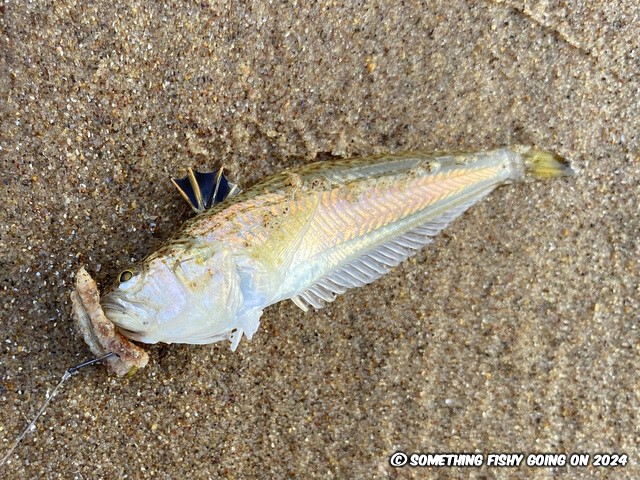Species hunting is fairly straight forward, once you know where to go hunting. Over the years, I’ve built up a good knowledge of places where certain species can reliably be caught at certain times of the year. Sometimes however, I’ll be fishing a venue that I thought I was very familiar with and be pleasantly surprised when I catch something I’ve never caught there before. This happened to me on Tuesday. Fishing at Newhaven Harbour in Edinburgh, I caught a sand goby, a species I’ve never caught there before.
 |
| My first ever sand goby at Newhaven Harbour. |
Two days later, I was fishing at the inlet area at Torness Power Station. It was very windy and things were very slow. When I finally caught a fish, it was yet another goldsinny wrasse, so I decided to go catch something else. Heading around to the outflow area, I spent thirty minutes there sight fishing for common goby from a large rockpool. There were lots of them present, and using tanago hooks baited with tiny pieces of ragworm, I soon caught a few and popped them in my photo tank. I also caught a small common blenny and popped it in the tank too, using the white push plate as a divider to keep the two species separate.
 |
| Common by name… |
 |
| …common by nature. |
On my way back, I took a detour and decided to try to catch a lesser weever. The eastern end of Belhaven Bay produces this small venomous fish at the end of the summer, so I headed there. Fishing a scaled down three hook flapper rig, with 4lb short snoods, small sections of ragworm baited onto #12 hooks and using a 14g lead, I cast out just past where the waves were breaking. Holding my ultra light rod in hand, I slowly wound in my rig along the sandy bottom. After a few casts, I felt a rattle and after a brief pause, wound in a small flounder.
 |
| There must be thousands of these along the length of the beach, feeding in just a few inches of water. |
With an easterly wind blowing, it was pretty cold, but I persevered, catching two more tiny flounder before a fourth bite produced what I was after, a lesser weever. Happy enough, and not wishing to further increase my chances of being stung, I carefully unhooked and returned it, called it a day and headed home having added another species to my 2024 tally.
 |
| The lesser weever, a nice looking little fish that lives in the sand. It has a nasty sting that causes a great deal of pain should its black dorsal fin or gill plate spines puncture your skin. |
On Thursday afternoon, I headed to fish in a drainage pond about an hour from Edinburgh. My mate Chris caught a lovely rudd there recently and was kind enough to share the location with me. He caught it on a dry fly, but I decided to fish a maggot under a puddle chucker float. It was a cold windy day, but thankfully the small body of water was low down in a depression, so I was slightly sheltered as I stood there fishing. Feeding a small amount of maggots fairly often, and casting my float repeatedly to try and induce a take “on the drop”, I missed a few very subtle knocks but after a few hours I’d had no luck catching my target for the day. A solitary small perch being the only thing preventing a blank. A reminder that just because you know where a species can be caught, doesn’t always mean you’ll catch it!
 |
| The blank saver. |
Summer is gone. Autumn is here. Winter will follow. A slightly depressing thought. As the temperature continues to drop, the fishing is going to get more difficult. Opportunities to get out will no doubt start to thin out too as conditions deteriorate. Anyway, on a much more positive note, the weather on Malta looks great over the next week or so, and I’m flying out there early tomorrow morning. I can’t wait for some species hunting fun in the sun! I’m also going on a three week trip to Singapore, Cambodia and Thailand in November, so I’ve still got plenty of species hunting to look forward to.
Tight lines, Scott.


No comments:
Post a Comment